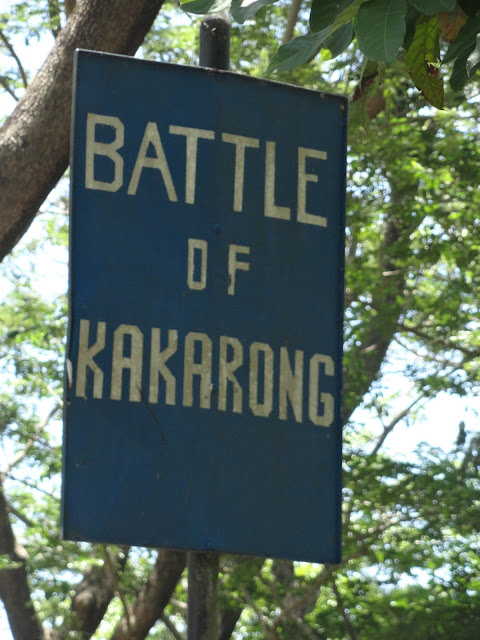Pandi, a municipality of Bulacan, is an unfamiliar place to me. Though Pampanga is just a stone throw away from Bulacan, figuratively speaking, I never had the chance to see the place. I just learned about it while our summer trip was being planned. Owing to the countless researches and readings of Dennis about the different Philippine historical sites, he was able to discover a lot of places that we normally have not paid much attention to.
But what could be significant about Pandi, Bulacan? To someone who has never been there, it would not even ring a bell. History says that Pandi has played a very significant and vital role in the fight for the Philippine Independence. Does it make sense now? Our main objective then was to trace the historical events that transpired at that time in our ancestors' effort to gain our independence. What we did then, in our travels, was like putting pieces of history together to be able to get the picture, at least, if not the whole picture.
We headed for Pandi after we went back to see the Museum of the Barasoain Church in Malolos. As I remember it, we went to the direction of Guiguinto, Bulacan and then Balagtas, Bulacan. We reached the poblacion of Pandi and we saw the Immaculada Concepcion Parish Church. The Church was old but the facade has been renovated. Its antiquity is evidenced inside the church by its retable and the ceiling. Fronting the church was a mini park of Jose Rizal.
 |
| Immaculate Concepcion Parish Church |
 |
| Panoramic View of the Inside of the Church |
 |
| Mini Rizal Park fronting the Church |
As we were heading east, I felt that we were going farther away from civilization because we began treading an unpaved road. It seemed to be road less traveled. It was quite a distance though until we reached our destination, the Real Kakarong de Sili. This is a small barangay where the bloodiest revolution took place in 1898. It is on this site where the 'Republic of Real de Kakarong de Sili'
of 1896, one of the first Philippine revolutionary republic was
established. It was in Kakarong de Sili, which about 6,000 Katipuneros
from various towns of Bulacan headed by Brigadaire General Eusebio Roque, better known as "Maestrong Sebio or Dimabungo" that the Kakarong Republic was organized shortly after the Cry of Pugad Lawin.
History and researchers, as well as records of the National Historical Commission,
tells that the 'Kakarong Republic' was the first and truly organized
revolutionary government established in the country to overthrow the
Spaniards antedating event the famous Malolos Republic and the Biak na Bato Republic. In recognition thereof, these three "Republics" established in Bulacan
have been incorporated in the seal of the province of Bulacan.
According to available records including the biography of General Gregorio del Pilar entitled "Life and Death of a Boy General" written by Teodoro Kalaw, former director of the National Library of the Philippines,
a fort was constructed at 'Kakarong de Sili' that was like a miniature
city. It had streets, an independent police force, a musical band, a
factory of falconets, bolos and repair shops for rifles and cartridges.
The 'Kakarong Republic' had a complete set of officials with Canuto Villanueva as Supreme Chief and 'Maestrong Sebio'- Eusebio Roque as Brigadaire General of the Army. The fort was attacked and totally
destroyed on January 1, 1897 by a large Spanish force headed by General Olaguer-Fellie. Gen. Gregorio del Pilar was only a lieutenant at that time and 'The Battle of Kakarong de Sili'
was his first "baptism of fire". This was where he was first wounded
and escaped to nearby barangay 'Manatal'.(Battle of Kakarong)
 |
| Welcome Arch of Real de Kakarong |
 |
| View as we were approaching the Inang Filipina Shrine |
 |
| Kakarong de Sili Shrine |
 |
| Inang Filipina Shrine |
The actual site of the "Battle of Kakarong de Sili" is now a part of the
Barangay of Real de Kakarong where the Kakarong Lodge No. 168 of the
Legionarios del Trabajo in memory of the 1,200 Katipuneros who perished
in the battle erected a monument of the "Inang Pilipina" in 1924. No
less than one of the greatest generals in the Philippines history,
General Emilio Aguinaldo, visited this sacred ground in the late
fifties. (Pandi History)
Having a little grasp of its history now makes me understand the sacrifice of life that our forebears have offered in exchange of our independence. Can you imagine if we were already born at that time? In which aspect could we have contributed to our history?
Since it is now considered as a park, we had our picnic here. It would have been nice if added amenities were offered at the park. It was evident that there was no supply of water and electricity. There was no evidence of a caretaker, as well. If there would have been, I am not really sure who was the person because as we approached the small gate to the shrine, I saw a man seated by the make-shift guard house but did not even bother to approach us.
We do not mind if we have been asked of an amount as a donation but, apparently, nobody was really in- charge of the place. Since this is a historic site, it would have been much appreciated if this site was preserved and well-maintained. I may not be in the position to be giving such remarks but I am just sharing my two-cents.






No comments:
Post a Comment